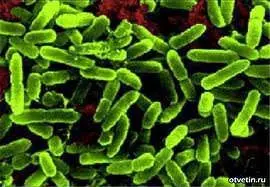Contents
Intestinal microflora
 Intestinal microflora in a broad sense, it is a collection of various microorganisms. In the human intestine, all microorganisms are in symbiosis with each other. On average, about 500 species of various microorganisms live in the human intestine, both beneficial bacteria (which help digest food and give vitamins and complete protein to a person) and harmful bacteria (which feed on fermentation products and produce decay products). Modification of the quantitative ratio and species composition of the normal microflora of an organ, mainly the intestine, accompanied by the development of microbes atypical for it, is called dysbacteriosis. Most often this happens due to malnutrition. But a violation of the microflora can occur not only due to malnutrition, but also due to the intake of various antibiotics. In any case, there is a violation of the microflora |
Normal intestinal microflora
The main representatives of the microflora of the human colon are bifidobacteria, bacteriods, lactobacilli, E. coli and enterococci. They make up 99% of all microbes, only 1% of the total number of microorganisms belongs to opportunistic bacteria such as staphylococci, proteus, clostridia, Pseudomonas aeruginosa and others. Pathogenic microflora in the normal state of the intestine should not be, the normal intestinal microflora in humans begins to develop already during the passage of the fetus through the birth canal. Its formation is completely completed by the age of 7-13.
What is the function of the normal intestinal microflora? First of all, protective. So, bifidobacteria secrete organic acids that inhibit the growth and reproduction of pathogenic and putrefactive bacteria. Lactobacilli have antibacterial activity due to their ability to form lactic acid, lysozyme and other antibiotic substances. Colibacteria antagonistically act on pathogenic flora through immune mechanisms. In addition, on the surface of the cells of the intestinal epithelium, representatives of the normal microflora form the so-called “microbial turf”, which mechanically protects the intestine from the penetration of pathogenic microbes.
In addition to the protective function, normal microorganisms of the large intestine are involved in the metabolism of the macroorganism. They synthesize amino acids, proteins, many vitamins, take part in cholesterol metabolism. Lactobacilli synthesize enzymes that break down milk proteins, as well as the enzyme histaminase, thereby performing a desensitizing function in the body. The beneficial microflora of the colon promotes the absorption of calcium, iron, vitamin D, preventing the development of the oncological process.
Causes of violation of microflora

There are a number of social factors that disrupt the microflora. This is primarily acute and chronic stress. Such “critical” conditions for human health affect both children and adults. For example, a child goes to the first grade, respectively, he worries and worries. The process of adaptation in a new team is often accompanied by health problems. In addition, during the learning process, tests, exams, and workload can cause stress.
Another reason why the microflora suffers is nutrition. Our diet today is high in carbohydrates and low in protein. If you remember what the diet of our grandparents included, it turns out that they ate much more healthy food: for example, fresh vegetables, brown bread – simple and healthy food that has a beneficial effect on the microflora.
Also, the cause of violations of the intestinal microflora are diseases of the gastrointestinal tract, fermentopathy, active therapy with antibiotics, sulfa drugs, chemotherapy, hormonal therapy. Dysbacteriosis is favored by harmful environmental factors, starvation, depletion of the body due to serious illnesses, surgical interventions, burn disease, and a decrease in the body’s immunological reactivity.
Prevention of microflora
In order to be in good shape, a person needs to maintain a balance of microflora that supports his immune system. Thus, we help the body resist stress and cope with pathogenic microbes on its own. That is why the microflora must be taken care of daily. This should become as common as brushing your teeth in the morning or taking vitamins.
Prevention of violations of microflora is aimed at maintaining beneficial bacteria in the body. This is facilitated by eating foods rich in plant fiber (vegetables, fruits, cereals, wholemeal bread), as well as fermented milk products.
Today, on TV screens, we are offered to start the day with a “sip of health”: kefirs and yogurts enriched with bifidobacteria. However, it must be remembered that the amount of these beneficial elements in products with a long shelf life is quite small in order to stimulate the growth of microflora. Therefore, as a preventive measure, it is worth considering fermented milk products (kefirs, tans, etc.), which contain truly “live cultures”. As a rule, these products are sold in pharmacy chains and their shelf life is limited. And, of course, do not forget about the rules of healthy eating, sports and mental balance – all this helps to maintain immunity at its best!









